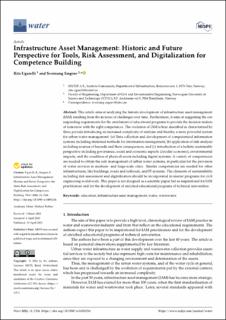| dc.contributor.author | Ugarelli, Rita Maria | |
| dc.contributor.author | Sægrov, Sveinung | |
| dc.date.accessioned | 2022-05-11T18:18:47Z | |
| dc.date.available | 2022-05-11T18:18:47Z | |
| dc.date.created | 2022-05-09T13:20:06Z | |
| dc.date.issued | 2022 | |
| dc.identifier.citation | Water. 2022, 14 . | en_US |
| dc.identifier.issn | 2073-4441 | |
| dc.identifier.uri | https://hdl.handle.net/11250/2995323 | |
| dc.description.abstract | This article aims at analyzing the historic development of infrastructure asset management (IAM) resulting from the increase of challenges over time. Furthermore, it aims at suggesting the corresponding requirements for the enrichment of educational programs to provide the decision makers of tomorrow with the right competences. The evolution of IAM is here described as characterized by three periods introducing an increased complexity of analysis and thereby, a more powerful system for urban water management: (a) Data collection and development of computerized information systems including statistical methods for information management; (b) application of risk analysis including sources of hazards and their consequences; and (c) introduction of a holistic sustainable perspective including governance, social and economic aspects (circular economy), environmental impacts, and the condition of physical assets including digital systems. A variety of competencies are needed to obtain the safe management of urban water systems, in particular for the provision of water services in medium- and large-scale cities. Similar competencies are needed for other infrastructures, like buildings, roads and railroads, and IT systems. The elements of sustainability including risk assessment and digitalization should be incorporated in master programs for civil engineering world-wide. This paper is not designed as a scientific paper, but as inspirational for IAM practitioners and for the development of enriched educational programs of technical universities. | en_US |
| dc.language.iso | eng | en_US |
| dc.publisher | MDPI | en_US |
| dc.rights | CC BY 4.0 | * |
| dc.rights.uri | https://creativecommons.org/licenses/by/4.0/ | * |
| dc.subject | Education | en_US |
| dc.subject | Infrastructure asset management | en_US |
| dc.subject | Water | en_US |
| dc.subject | Wastewater | en_US |
| dc.title | Infrastructure Asset Management: Historic and Future Perspective for Tools, Risk Assessment, and Digitalization for Competence Building | en_US |
| dc.title.alternative | Infrastructure Asset Management: Historic and Future Perspective for Tools, Risk Assessment, and Digitalization for Competence Building | en_US |
| dc.type | Peer reviewed | en_US |
| dc.type | Journal article | en_US |
| dc.description.version | publishedVersion | en_US |
| dc.rights.holder | © 2022 The authors | en_US |
| dc.subject.nsi | VDP::Teknologi: 500 | en_US |
| dc.source.pagenumber | 11 | en_US |
| dc.source.volume | 14 | en_US |
| dc.source.journal | Water | en_US |
| dc.identifier.doi | 10.3390/w14081236 | |
| dc.identifier.cristin | 2022702 | |
| dc.source.articlenumber | 1236 | en_US |
| cristin.ispublished | true | |
| cristin.fulltext | original | |
| cristin.qualitycode | 1 | |

